Data entry is one of the most basic vital tasks for businesses and accountants when dealing with financial information.
Along with this task comes significant costs and certain risks that accounting firms and businesses are prone to.
In this blog, we’ll talk about how to outsource data entry in 2025 and what are the benefits of doing it.
Key Takeaways:
- Outsourcing data entry allows businesses to focus on core tasks by leveraging external expertise for accuracy and cost-efficiency, enabling scalability and access to a diverse skill set.
- Critical considerations for outsourcing include data sensitivity, volume, cost-effectiveness, the outsourcing model (onsite, nearshore, offshore, multisource), and the vendor’s reputation and capability for scalability.
- Data entry outsourcing services vary, including PDF data entry, data conversion, and extraction for online databases, each impacting price and resource availability.
- Comparing outsourcing to automation, automation offers cost savings and efficiency for repetitive tasks, while outsourcing provides flexibility and human insight for complex data management, necessitating a balanced assessment of business needs.
What Does It Mean Outsourcing Data Entry?
Outsourcing data entry means hiring an external service to handle your business data entry tasks whether it is for accounting, sales, finance, supply chain, or other tasks.
This approach frees up internal resources, allowing your team to focus on core activities.
Companies gain access to specialized skills and technology not available in-house through outsourcing. It shifts the burden of data management and accuracy to experts, ensuring high-quality data handling.
Outsourcing can also be cost-effective, eliminating the need for investing in additional staff or technology. Many companies choose to work with an offshore development team in Ukraine, Poland, Romania benefiting from high-quality expertise at a competitive cost.
It offers flexibility, and scaling with your business needs especially when the increase in workload is only seasonal or temporary.
Why Businesses Outsource Data Entry?
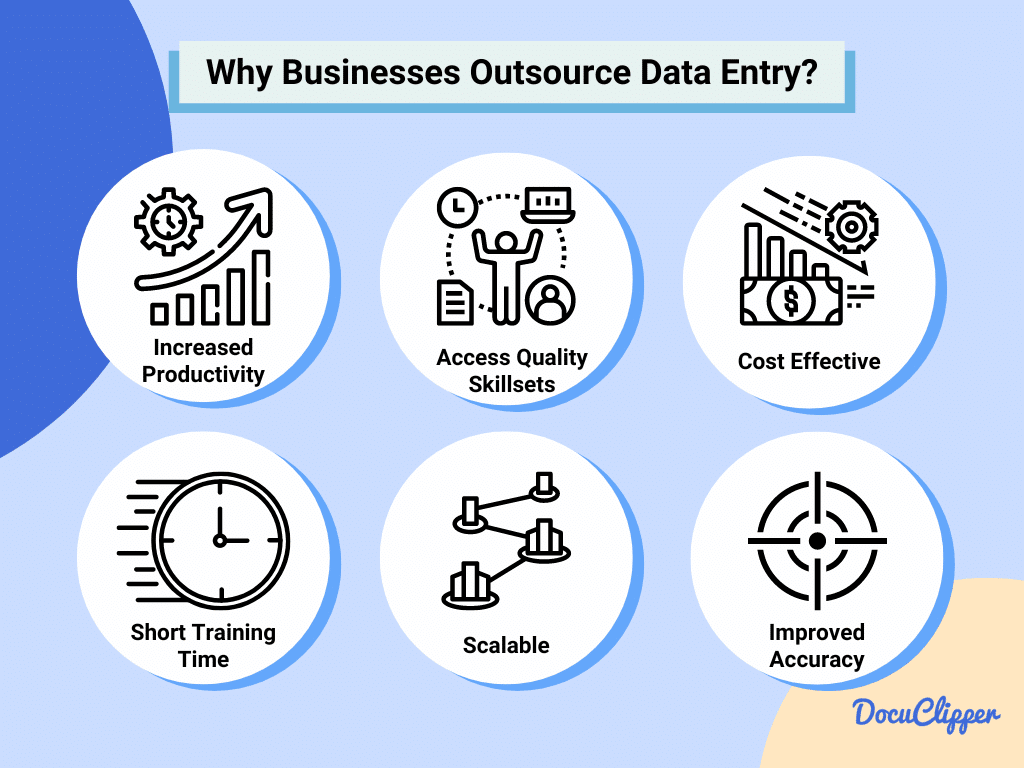
Outsourcing data entry offers several compelling advantages for businesses looking to streamline operations and boost efficiency.
Here’s a closer look at why companies choose this path:
- Increased Productivity: Companies that outsource their data entry tasks often see a productivity boost of up to 24%. This significant improvement stems from freeing internal resources to focus on core business functions, driving growth and innovation.
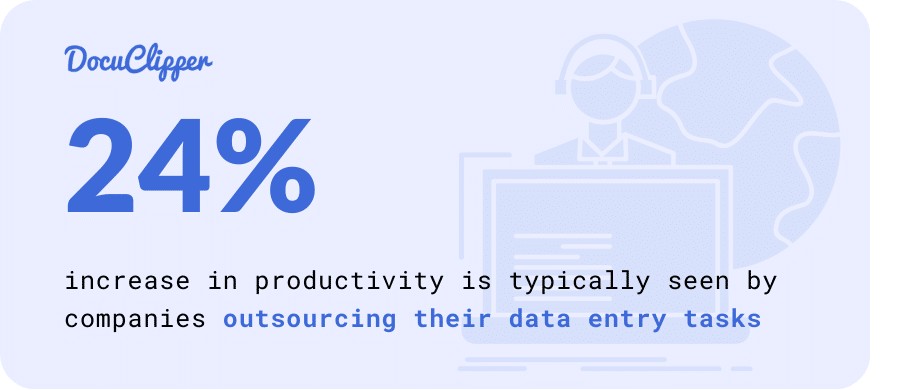
- Access to a Large Pool of Skillsets: With 51% of workers holding postgraduate degrees engaging in freelance work, businesses have unprecedented access to a diverse set of skills. This talent pool includes experts in computer programming, marketing, IT services, and business consulting.
- Cost-Effectiveness: According to Deloitte’s Global Outsourcing Survey, 63% highlight cost reduction as a crucial advantage. Outsourcing eliminates the need for significant investment in hiring and training new employees, making it a financially savvy option.
- Reduced Training Requirement: The majority of outsourced services are provided by individuals with advanced degrees and long-term experience, significantly reducing the need for extensive training. This ensures that tasks are handled by competent professionals from the start.
- Scalability: Business Process Outsourcing (BPO) companies offer scalable solutions that adapt to your business’s changing needs. With flexible service packages and minimal setup time, scaling operations become seamless and efficient.
- Improved Accuracy: Specialized BPO providers bring a high level of professionalism and expertise to data entry tasks, resulting in superior accuracy. Their focus on data management ensures that businesses receive reliable, error-free data, supporting informed decision-making.
What Factors to Consider When Outsourcing Data Entry
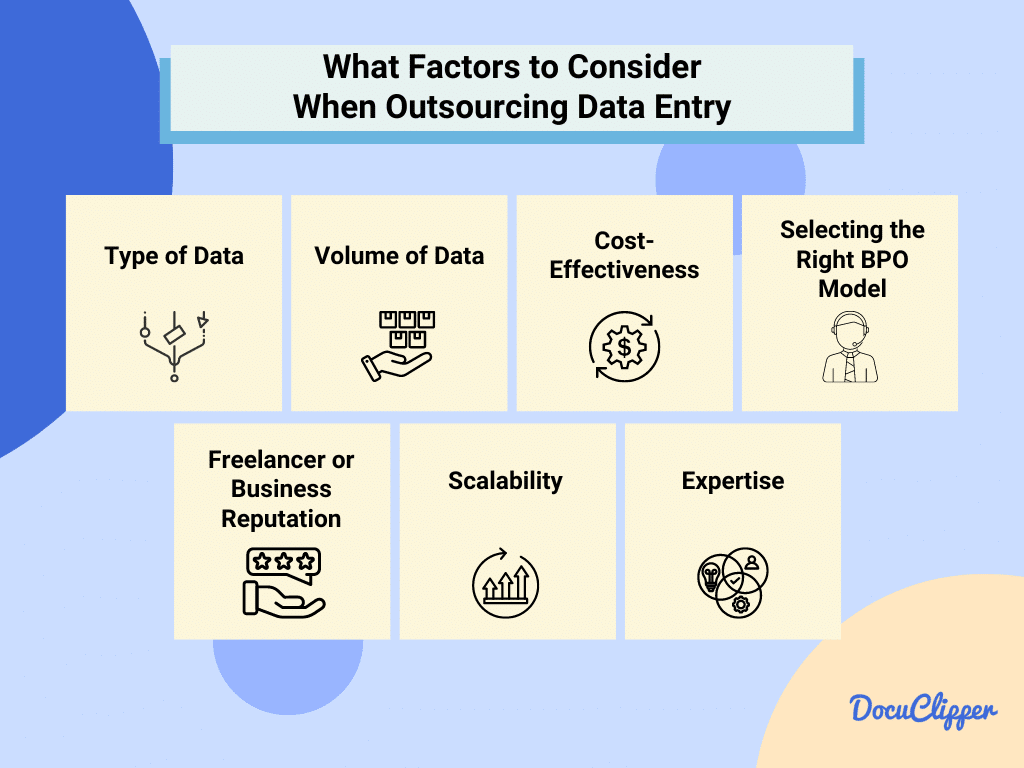
When outsourcing data entry, businesses must consider several crucial factors to ensure the process aligns with their operational needs and security standards. These considerations help in making an informed decision that benefits the company in the long term.
Type of Data
The nature of the data is the priority of what type of outsourcing data entry service should you acquire.
Sensitive information, such as legal documents, medical and financial records, patents, and company secrets, demands higher security measures and specialized handling.
Such data might not be suitable for outsourcing due to confidentiality concerns, requiring in-house management instead.
Financial data, for example, requires knowledge of accounting and bookkeeping, while statistical data should be handled by qualified statisticians to maintain integrity and accuracy.
Volume of Data
The capacity of the freelancer or outsourcing company to handle your data volume is another critical factor. It’s essential to discuss their ability to manage the workload at the desired pace.
Not all providers have the same capabilities, and ensuring they can meet your demands is key to a successful partnership.
Cost-Effectiveness
Weighing the cost benefits of outsourcing against hiring internally is crucial.
In the US, the average salary for data entry personnel is $43,458 annually, whereas, in outsourcing hubs like the Philippines, the cost can be as low as $300 per month.
This significant difference can offer substantial savings, making outsourcing a financially attractive option.
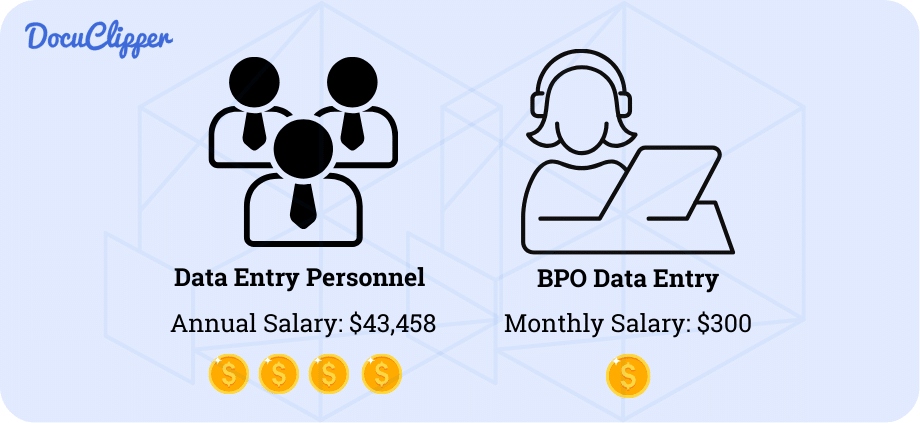
But it does not mean it is cheaper, it has the same quality. Inquire for a trial and see if it is worth it.
Do you want to know how to learn data entry? Visit our article to learn more.
Selecting the Right BPO Model
The choice of the Business Process Outsourcing (BPO) model impacts collaboration and efficiency.
Not all businesses are made equal, so be cautious about the BPO model you are planning to acquire as these have differences in cost and the quality of work..
- Onsite BPO Model:
- Involves outsourcing professionals working directly within your company’s premises.
- Facilitates direct communication and collaboration.
- Best for projects requiring high levels of security or immediate feedback as well as on-site workers.
- Nearshore BPO Model:
- Outsourcing to service providers located in neighboring countries or regions.
- Offers similar time zones and cultural affinities, easing communication.
- Suitable for companies seeking a balance between cost efficiency and ease of collaboration.
- This could be for businesses that need to know the local environment, laws, taxes, etc.
- Offshore BPO Model:
- Involves partnering with companies in distant countries, often on different continents.
- Provides significant cost savings due to lower labor costs in these regions.
- Ideal for businesses looking for the most cost-effective solutions and those with projects that have less need for real-time communication.
- Typically for tasks that do not differ if the person is in a different country. For example, uploading documents into the software will be done always the same anywhere in the world.
- Multisource BPO Model:
- Combines services from multiple providers, possibly across different BPO models (onsite, nearshore, offshore).
- Offers flexibility and access to a broad range of expertise and technologies.
- Best for complex projects requiring a variety of specialized skills or for companies seeking to mitigate risks by not relying on a single provider.
Freelancer/Business Reputation
Especially when handling sensitive data, the reputation of the outsourcing partner is crucial. Investigate their track record by reading reviews, checking social media comments, and, if possible, speaking with current and former clients.
This research helps ensure you select a reliable and trustworthy service provider.
You can also ask them for references.
However, if they start talking about NDAs and that they can’t prove anything, then you better stay away from them or ask them if you’re their first client.
Scalability
Outsourcing to companies typically allows for easier scaling, as they offer a large pool of data entry clerks who can readily adjust to workload changes. This setup enables quick scalability and internal knowledge sharing, making it efficient for growing demands.
In contrast, scaling with freelancers involves searching for and training new hires individually, which can be time-consuming for businesses with fluctuating needs.
Expertise
Outsourcing companies often bring a broad spectrum of experience to the table, equipped with the necessary tools and personnel to meet various data entry requirements. Verifying their expertise, especially in relation to your specific needs is important.
Freelancers, while potentially highly specialized, require careful selection to ensure they possess the right skills and tools for your project. In deeply niche areas, they can be the right job for you but there might be issues in scaling.
Types of Data Entry Outsourcing Services:
Data entry outsourcing services offer a variety of solutions to manage and process information efficiently. The type of service has effects on price and the scarcity of the human resources that can handle it. These services include:
- PDF Data Entry: Transferring information from PDF files into digital formats, making word and numerical data accessible and editable.
- Copying/Pasting Information: Moving data from one source to another with precision, suitable for various documentation needs.
- Data Conversion (OCR): Utilizing Optical Character Recognition technology to convert different types of documents into digital data, enhancing accessibility and searchability.
- Converting Scanned PDFs: Transforming scanned PDF documents into MS Excel, Word, or other formats, making the data usable for analysis and reporting.
- Extracting Data for Online Databases: Gathering information from documents and entering it into online databases, supporting efficient data management and retrieval.
- PDF Document Indexing and Archiving: Organizing PDF documents through indexing, making them easily searchable, and archiving them for secure, long-term storage.
How to Outsource Data Entry in Your Company: Step-by-Step Guide
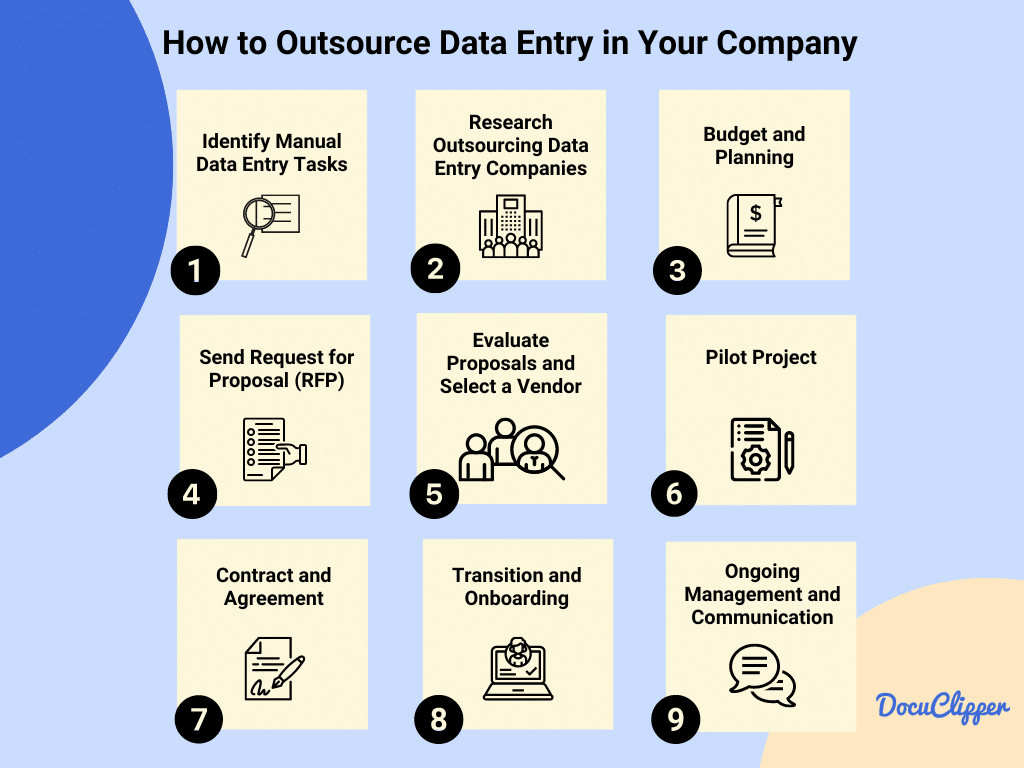
When you are already done considering what type of data entry outsourcing service you need, here are some steps you can take to start putting it all together:
Step 1: Identify Manual Data Entry Tasks
Start by listing all manual data entry tasks within your company. Evaluate each task to determine if it can be replaced or streamlined through outsourcing.
For example, if your employees spend too much time on inputting customer information into databases, processing invoices, or updating inventory levels, these activities could be prime candidates for automation or outsourcing.
This step helps in pinpointing the specific areas where outsourcing can provide the most benefit, improving efficiency and productivity.
Of course, it’s always important to weigh the benefits of outsourcing the manual tasks or keep doing it.
If the tasks take only a few minutes a week, then there is no point in spending time and resources on outsourcing it as it would have minimal impact on your business and perhaps you would end up losing more than gaining.
Step 2: Research Potential Outsourcing Data Entry Companies
The second step is to identify potential data entry service providers.
This could include both local companies and international firms, each offering different advantages.
Local firms might provide easier communication and a better understanding of regional market nuances, while international companies can offer competitive pricing and a wider talent pool.
Assess each option based on your specific business needs, considering factors like time zone differences, language barriers, and cultural compatibility.
Extensive research helps compare the quality, expertise, and pricing of various services, facilitating an informed decision that aligns with your company’s objectives and operational demands.”
Step 3: Budget and Planning
Assess the cost versus quality to determine if outsourcing offers a tangible benefit for your company.
This financial analysis is important. If outsourcing does not offer cost savings or quality improvement, it may not be the right decision.
Careful planning at this stage ensures resources are allocated effectively.
Smaller tasks are often not worth outsourcing unless they require specialized knowledge that you don’t have within your organization.
Step 4: Send Request for Proposal (RFP)
Once you’ve established a budget and know how much you’re willing to spend, reach out to potential companies and freelancers with a Request for Proposal (RFP).
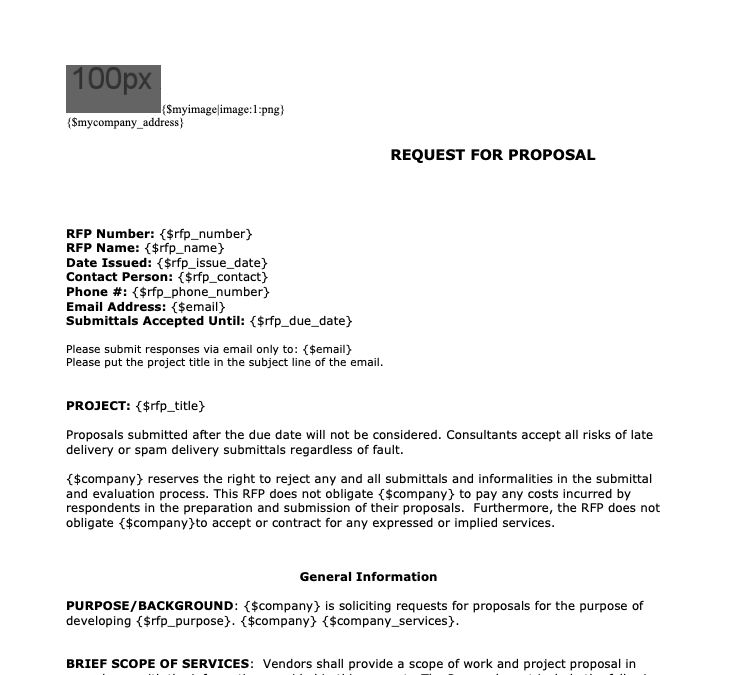
This document should outline your requirements, allowing service providers to submit customized proposals for your consideration.
Step 5: Evaluate Proposals and Select a Vendor
Review the proposals you receive to identify the most cost-effective option that promises timely and high-quality output.
It will help you to better understand what’s the typical cost for such services as asking only one vendor can lead to getting overcharged for the service.
That’s why it’s important to get proposals from several vendors, we recommend at least 3-5.
This evaluation is important in selecting a vendor that aligns with your business goals and can meet your data entry needs efficiently.
Step 6: Pilot Project
Before committing fully, initiate a pilot project with the chosen vendor or a few selected vendors.
This smaller-scale project serves as a practical test to evaluate the vendor’s capability to meet your expectations. It provides insight into their work quality and reliability.
You can treat it like an internship or a probation period when they are employed. In this stage, they can also back out when they are not fine with the type of work.
Step 7: Contract and Agreement
Engage a lawyer or contract specialist to draft an agreement that protects your interests and negotiate terms that benefit both parties. This legal step ensures clarity and security in the outsourcing partnership.
In this draft also lies rules, regulations, and compensation between the parties. If things get out of hand, you can rely on this contract for a legal basis.
Step 8: Transition and Onboarding
With the contract signed, dedicate time for an onboarding program. This phase is essential for integrating the outsourcing team into your operations, helping them understand their roles, the company culture, and how their work impacts the business.
If you are uncomfortable with sharing the entire business process, you can just show off the departments they’ll be working for.
Step 9: Ongoing Management and Communication
Maintain regular communication with your outsourcing partner through daily emails, update reports, and scheduled calls. Consistent interaction ensures smooth operations, allows for timely adjustments, and builds a strong working relationship.
Automating vs Outsourcing Data Entry: Differences, Pros and Cons
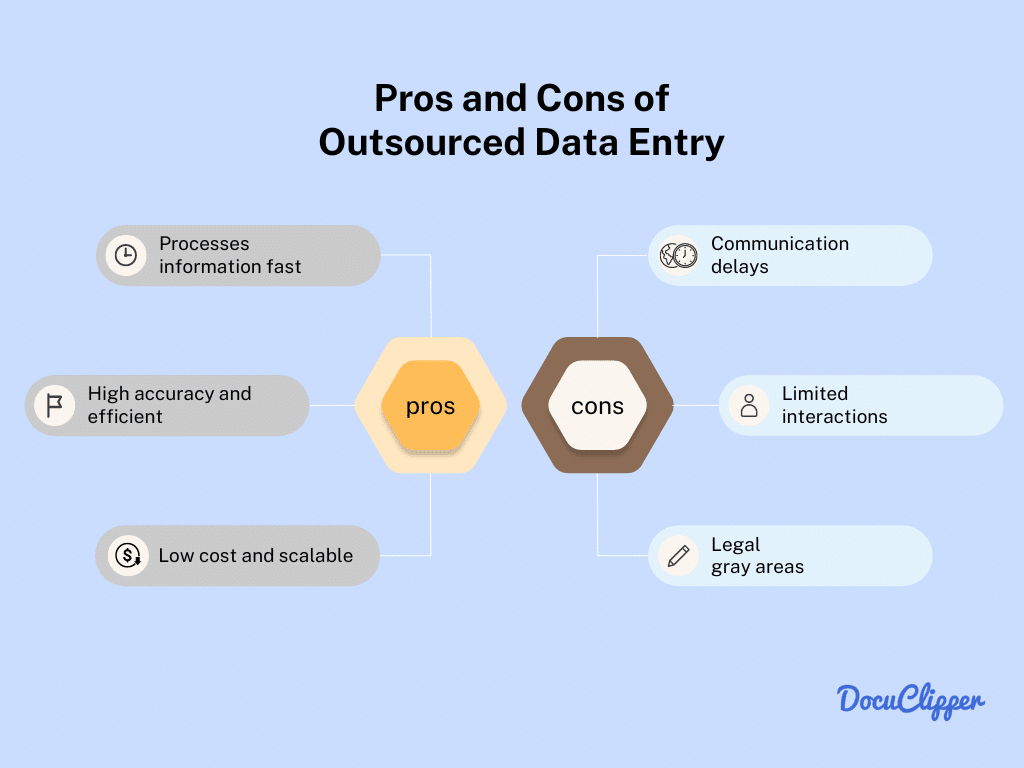
Another alternative for outsourcing is just to go with automated data entry. Automated data entry is using software and tech for data entry. An example is using an OCR bank statement converter that converts bank statements in PDF to XLS or CSV.
Here are the main differences between outsourcing and automating your business’s data entry process
Cost
Automated data entry software, such as an OCR bank statement converter, is priced at around $39 per month. This is significantly less than hiring a data entry expert from the Philippines, who may cost approximately $300 per month.
Automation has the advantage as it offers a cost-effective solution for repetitive tasks, reducing the financial burden associated with manual data entry.
Efficiency
Manual data entry is often outsourced. It involves human operation with an average processing time of 3 minutes per financial document. In contrast, OCR software can process a document in about 20 seconds and do this for many documents at once.
Automation is more beneficial because it dramatically increases efficiency, handling tasks at a speed that manual processing can’t match.
Scalability
The efficiency of manual data entry decreases over time, particularly as the workload increases. Automated systems, however, maintain a consistent processing time, even as document volume scales up to 100 or more. This makes automated data entry a more scalable option for businesses experiencing growth.
Accuracy
While outsourced manual data entry can achieve an accuracy rate of 95-99%, automated data entry systems boast an accuracy rate of up to 99.5%. The precision of automated systems minimizes the risk of errors, ensuring higher data quality. As errors can incur heavy financial losses in the bookkeeping industry, an accurate choice is also a cost-effective one.
Control
Outsourced data entry allows for direct communication and instructions, albeit with potentially longer delivery times. Automated systems operate based on predefined settings, offering less flexibility in real-time adjustments but ensuring consistent output without the need for ongoing oversight.
Flexibility
Manual outsourcing offers adaptability to specific project requirements but at a higher cost. Automated systems follow established algorithms, though some software solutions can be customized with additional features to meet unique needs, providing a balance between flexibility and cost.
Security
Security concerns vary between methods. Local outsourcing companies may offer more accountability and legal recourse in case of data breaches, aligning with local laws.
But for offshore companies, your legal protection is very limited.
Automated systems face cybersecurity risks, yet proper security measures and protocols can mitigate these threats, ensuring data protection.
Conclusion
In conclusion, deciding between automating and outsourcing data entry depends on your business’s specific needs, including cost, efficiency, scalability, accuracy, control, flexibility, and security considerations.
Automation offers speed, consistency, and cost savings, ideal for repetitive tasks.
Outsourcing provides flexibility and human insight, suitable for complex or varied data management needs. Weighing these factors will help you choose the best approach to optimize your data entry process, enhance operational efficiency, and secure your business data effectively.
How DocuClipper Can Help Automating Your Data Entry?
Discover how DocuClipper can revolutionize your data entry process, transforming tedious manual work into a seamless, automated flow. With its cutting-edge OCR technology tailored specifically for bank statement conversion and analysis, DocuClipper offers unmatched accuracy, rapid processing times, and comprehensive transaction insights.
Whether you’re a small business or a large corporation, DocuClipper’s scalable solutions are designed to meet your unique needs. Don’t let manual data entry slow you down.
Take the first step towards efficiency and accuracy; try DocuClipper today and experience the future of financial document management. Visit our website to learn more and sign up for a free trial.
FAQs about Outsourcing Data Entry
Here are some frequently asked questions by businesses when they are planning in outsourcing data entry:
What does it mean to outsource data?
Outsourcing data refers to the practice of hiring third-party service providers to handle data-related tasks, such as data entry, data processing, and data management. This allows companies to focus on their core activities while leveraging the expertise and technology of specialized firms.
Why do companies prefer outsourcing data entry work?
Many companies opt to outsource data entry tasks to cut down on operational costs, enhance work quality through specialized skills, and improve overall efficiency by focusing on their main business functions.
What is data process outsourcing?
Data process outsourcing is the practice of entrusting external agencies with data-related tasks, such as processing and management, to leverage advanced technologies and expertise, thereby streamlining operations and increasing productivity.
Why outsourcing is a better option?
Outsourcing emerges as a superior choice for many businesses due to its significant cost savings, access to a global talent pool, and the flexibility to scale operations according to demand, all while maintaining a focus on core business strategies.
Why is it better to outsource?
The decision to outsource is advantageous because it allows companies to benefit from specialized expertise and advanced technologies, improve efficiency, and enhance the quality of service offerings without substantial capital expenditure.
Who benefits the most from outsourcing?
Small to medium-sized businesses stand to gain the most from outsourcing. It enables them to access the same level of expertise and technological resources as larger companies, without the need for heavy investment in infrastructure or personnel.
What are the benefits and disadvantages of outsourcing?
The primary benefits of outsourcing include reduced operational costs, access to specialized skills, and the ability to focus more on strategic business activities. However, it can also lead to challenges such as reduced control over business processes and potential issues with service quality and communication.
Related Articles:
- Automated Data Entry Guide: Transforming Businesses Efficiently
- Ultimate Guide to Automated Bookkeeping: Saving Time & Money
- How to Categorize Expenses in Excel (Template Included)
- How To Automate Manual Data Entry – Best Tips & Software
- What is Incremental cash flow and how to calculate it
- How to Read a Brokerage Statement
- How Long to Keep a Brokerage Statement



